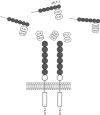Placental growth factor and pre-eclampsia
- PMID: 29115294
- PMCID: PMC5680413
- DOI: 10.1038/jhh.2017.61
Placental growth factor and pre-eclampsia
Abstract
Placental growth factor (PlGF) is an increasingly important molecule in the prediction, diagnosis and treatment of pre-eclampsia. It has pro-angiogenic effects on the feto-placental circulation and supports trophoblast growth. Mechanisms by which PlGF expression is regulated continue to be investigated. Low circulating PlGF precedes the manifestation of clinical disease in pre-eclamptic pregnancies and intrauterine growth restriction. This suggests that low PlGF is a marker of abnormal placentation, but it remains uncertain whether this is a cause or consequence. Prediction of pre-eclampsia using PlGF is promising and may assist in the targeting of resources to women at highest risk of adverse pregnancy outcomes. Promisingly, experimental animal models of pre-eclampsia have been successfully treated with supplemental PlGF. Treatment of pre-eclampsia with PlGF is a potential therapeutic option requiring further exploration. This review focuses specifically on the role of PlGF in normal and pathological placental development and in the clinical management of pre-eclampsia.
Conflict of interest statement
The authors declare no conflict of interest.
Figures


References
-
- Arad A, Nammouz S, Nov Y, Ohel G, Bejar J, Vadasz Z. The Expression of neuropilin-1 in human placentas from normal and preeclamptic pregnancies. Int J Gynecol Pathol 2016. - PubMed
-
- Khaliq A, Dunk C, Jiang J, Shams M, Li XF, Acevedo C et al. Hypoxia down-regulates placenta growth factor, whereas fetal growth restriction up-regulates placenta growth factor expression: molecular evidence for ‘placental hyperoxia’ in intrauterine growth restriction. Lab Invest 1999; 79(2): 151–170. - PubMed
-
- Xu L, Cochran DM, Tong RT, Winkler F, Kashiwagi S, Jain RK et al. Placenta growth factor overexpression inhibits tumor growth, angiogenesis, and metastasis by depleting vascular endothelial growth factor homodimers in orthotopic mouse models. Cancer Res 2006; 66(8): 3971–3977. - PubMed
-
- Van de Veire S, Stalmans I, Heindryckx F, Oura H, Tijeras-Raballand A, Schmidt T et al. Further pharmacological and genetic evidence for the efficacy of PlGF inhibition in cancer and eye disease. Cell 2010; 141(1): 178–190. - PubMed
Publication types
MeSH terms
Substances
LinkOut - more resources
Full Text Sources
Other Literature Sources

